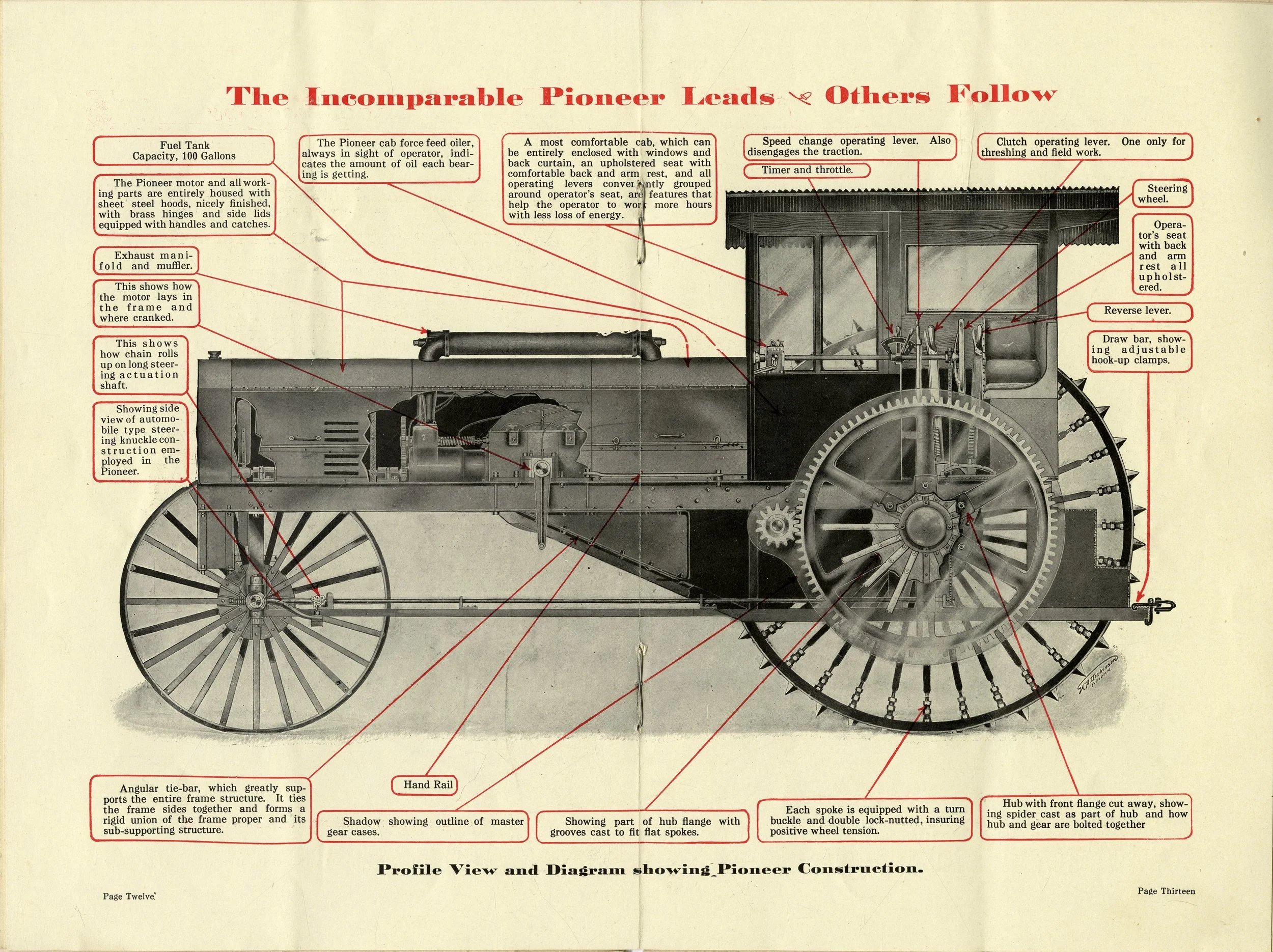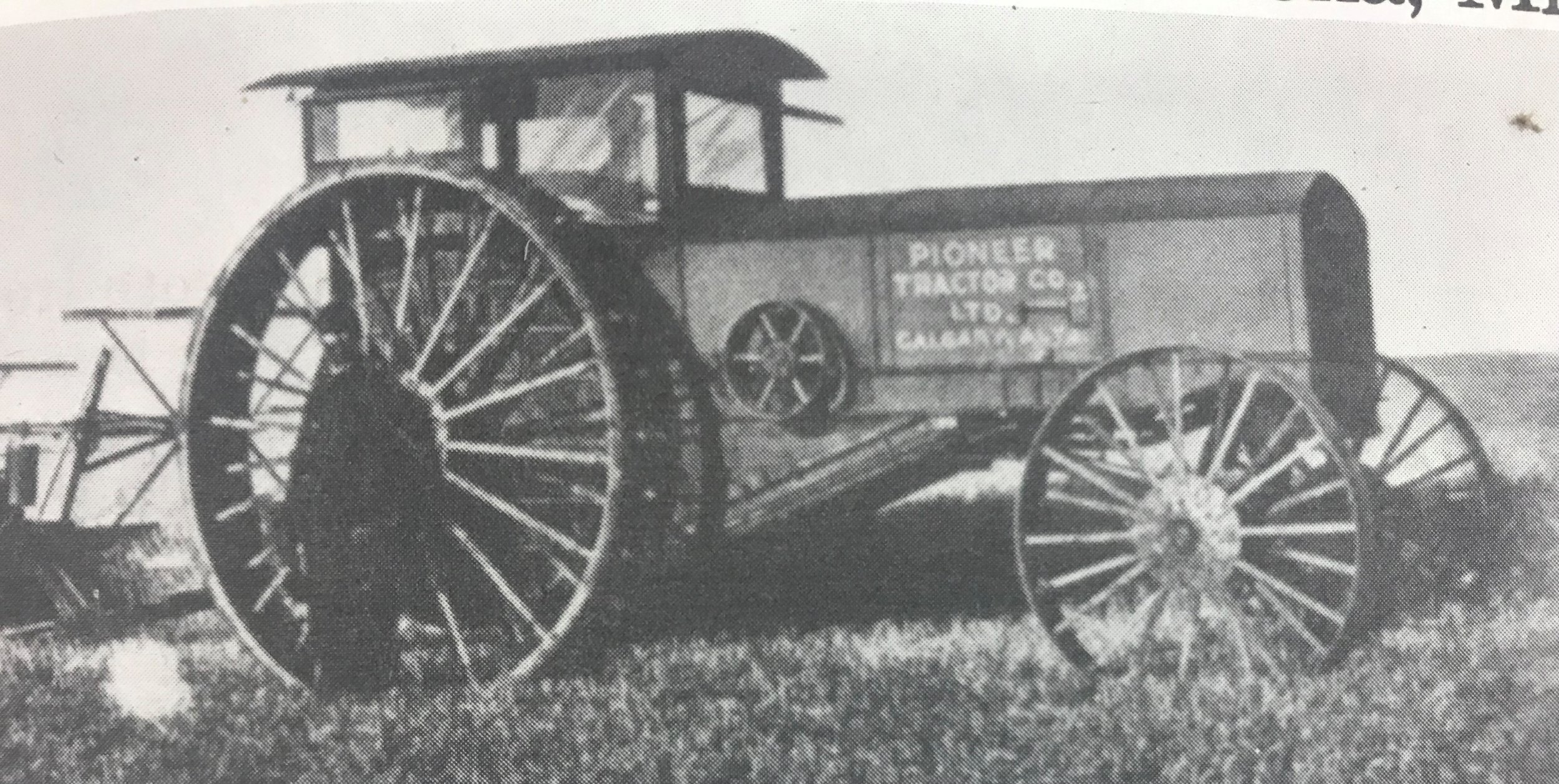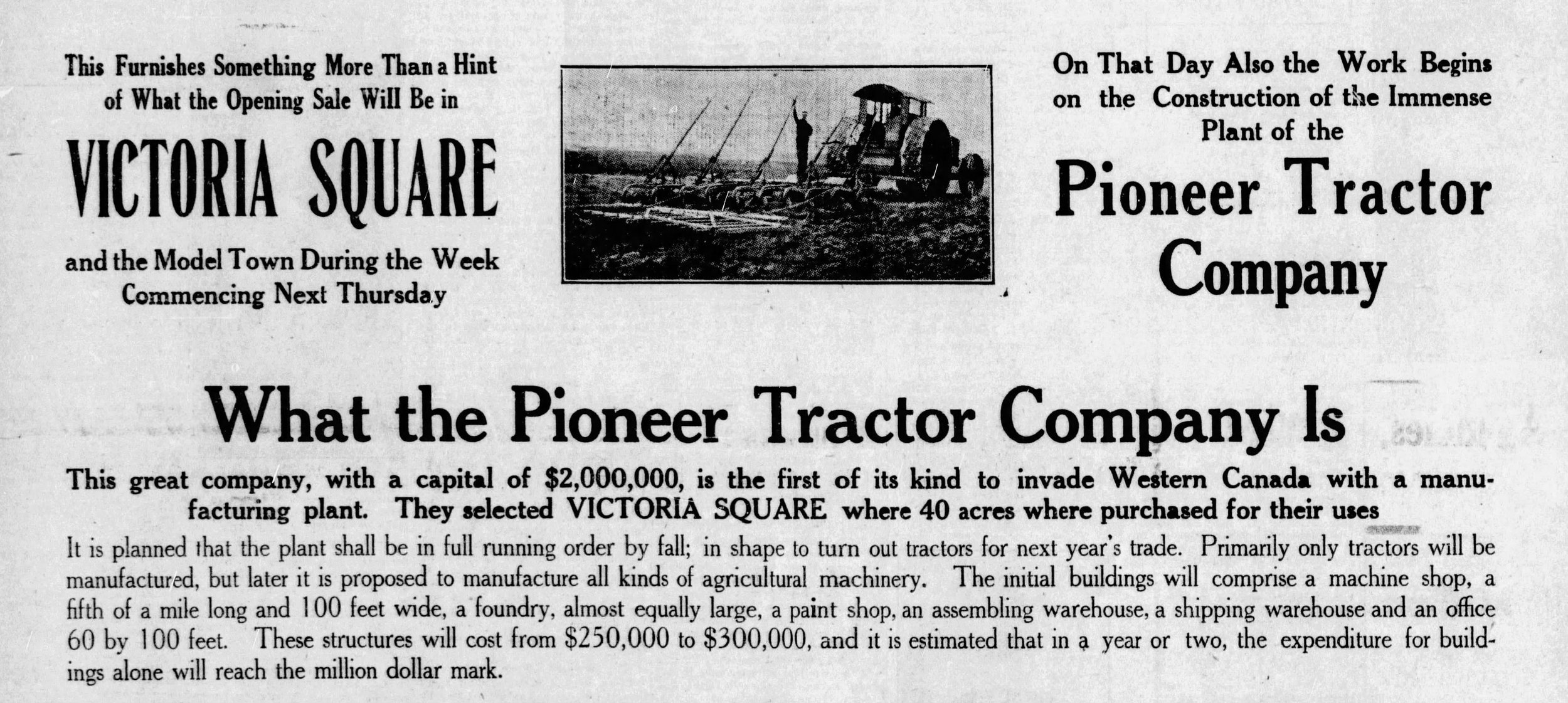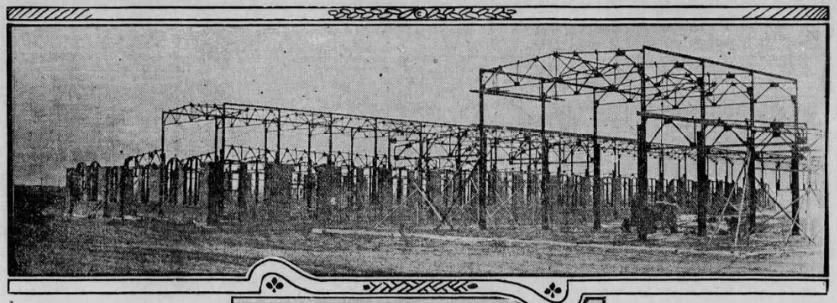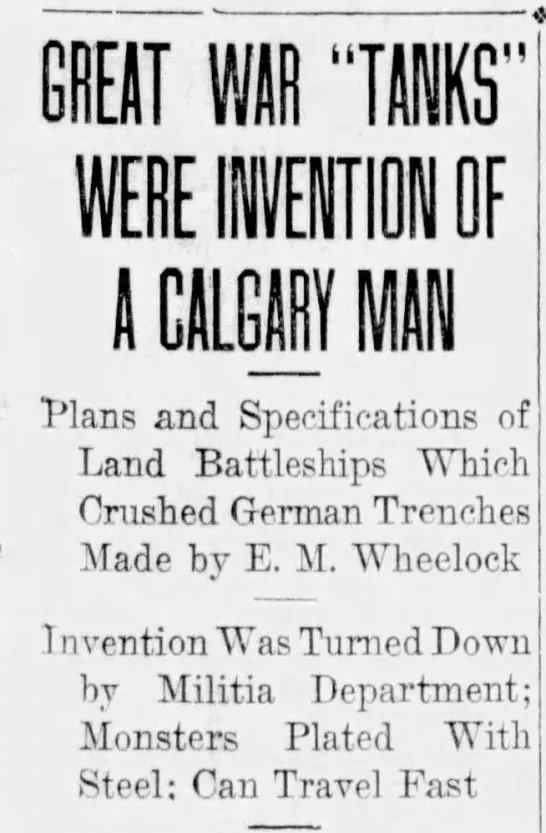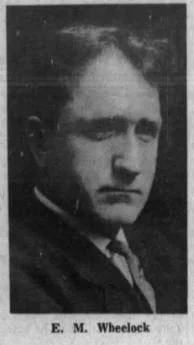Historian in Residence: The Pioneer Tractor Company
Shelly McElroy is the 2022 Historian in Residence
The Incomparable Pioneer. Image supplied by Shelly McElroy.
Made for Each Other: Calgary and Pioneer
Just as Albertans today watch the comings and goings of oil and gas and tech companies into our province hoping for the creation of jobs and the bolstering of our economy, one hundred years ago it was the agricultural manufacturers that could really make a community thrive.
In 1912, local papers were reporting that the Pioneer Tractor Company of Winona, Minnesota had demoed some of their products in Calgary. “The [tractor] engine starts from a crank and might easily be operated by one man,” was the impressed analysis. It added, “One of the hardest things on modern farm machinery is the fine dust, which rises from the ground and penetrates to the utmost parts of the machine. The Pioneer Tractor Company believe that they have surmounted this obstacle by their system, which is to build all the working parts in tight covers, which prevents this dust nuisance.” It would be ten years before other manufacturers routinely enclosed all working gears to protect them.
Pioneer 45 built in Calgary, Alberta. Image provided by Shelly McElroy.
The company was also so confident in its smooth-running engine that they paid a photographer to take a time lapse photo every one second for a full minute whilst a coin balanced on the crankcase of the tractor, with the engine revved to 550 RPM. The coin, the company claimed, would not fall or even wobble – and the photographer later swore in front of a notary that there had been no trickery in the images he took that day.
But the banner news in the story was the update that the company might be establishing a plant to build their tractors right here in Calgary.
In 1912, Alberta was experiencing the high of its first boom, for the economy was in a period of what must surely have seemed like boundless growth. An estimated 30,000 American settlers arrived in 1912 alone; there were so many newcomers that there was a rumor that the U. S. Secretary of Agriculture was planning a campaign to dissuade Americans from making the move to thriving Alberta. Real estate was flourishing, and investment in new developments had become a popular – and perilous – spiral. For example, residential lots in Calgary that had been worth $100 were now selling for upwards of $6,000. And while natural gas, mining and construction companies were thriving, agriculture was the economic heart of investment.
The Pioneer Tractor Company and Calgary seemed made for each other. Pioneer was new on the scene and had only been in business since 1909. Located in Winona, Minnesota, they were interested in marketing their products in Canada, but Canadian tariffs on imported farm machinery added significantly to the expense of imported tractors so Pioneer was considering building a large factory in Calgary as a way of dodging the Canadian tariffs. In Alberta in 1913, it was estimated that only two percent of arable land had been broken. The massive tractors assembled by Pioneer were made for exactly the purpose of turning prairie sod into bountiful farmland. “The Pioneer Does the Work of 30 Horses!” was the triumphant claim.
Double-discing 125 acres, daily. Image provided by Shelly McElroy.
In February of 1913, The Morning Albertan confirmed that Victoria Square was going to be the site of the new plant. Across the border in the United States, the Winona Republican-Herald in Minnesota also reported on the visit of Pioneer’s Vice President E. M. Wheelock to western Canada to determine the possibility of opening a factory. It confirmed the plans to locate a new facility in Calgary and described that the amenities were intended to be twice the size of the holdings in Winona. They made it clear that the new facilities at Calgary would be building tractors, not just assembling them.
Victoria Square was a small community located four miles east of Calgary. It had been the site of a government watering station and the area was known for its large supply of good well water. It was also located along the Grand Trunk Railroad line, and these could have been the reasons why Pioneer chose to set up their operations where they did.
The Victoria Square “Model Town” had been conceived by the Alberta Financial Brokers in 1911, and real estate agents Lavender & Horner were enlisted to promote the community and recruit buyers, some of whom were from faraway places like England and Montreal. The amenities at Victoria Square included a hotel, a Buckeye Tool Factory, a jam factory, a brickyard, and proximity to Rockland School. The school was originally located in the former Chinese Café but a fine new brick building eventually opened in 1915. Church and Sunday School services were also held in the school, and the minister and schoolteacher both lived in the Victoria Square Hotel. “The Square was a real Swinger,” recalled a community member, and the fondest memories were recalled of the dances held in the hotel.
Calgary Albertan, May 1912. Image provided by Shelly McElroy.
Pioneer acquired 40 acres in Victoria Square, and their choice to locate near Calgary was seen as a boon to western industry – no longer were farmers reliant on manufacturers in the eastern half of the country to supply them with products that they needed to run their businesses. Pioneer was also expected to employ three hundred men in its first year alone. In addition to two large assembly shops, one more than a block long, a 150-foot square building was also built for the other manufacturing processes required to turn out and repair their equipment. The bricks were locally supplied by the brick factory; bricks from this sandstone factory were also used in the construction of buildings in downtown Calgary.
Victoria Square was projected to be a large, substantial, and stable community that would benefit Albertans, and Alberta, for the long haul. It was also situated near the planned streetcar route that would connect Chestermere to Calgary. In their publicity for their new community, the triumphant news that the Pioneer Tractor Company would be the anchor of the new development was a key part of the Lavender & Horner advertising. In April of 1913, the Calgary Herald published photographs showing the massive Pioneer Tractor building under construction. It opened in July of that same year.
Pioneer Tractor Company plant under construction at Victoria Square. Calgary Herald, 26 Apr 1913.
The Armoured Tractor
The arrival of Pioneer was of course very interesting timing. Just over a year after the company appeared in Victoria Square, Canada was going to be engulfed in a long and deadly conflict in faraway Europe that would have economic implications for many businesses.
E. M. Wheelock, the President and General Manager of Pioneer Tractor in Calgary, was described as ‘a mechanical genius’ and it was noted that ‘Mr. Wheelock in his work has tried out very thoroughly all possible construction that could be utilized in a gas traction engine, and the machine that the Pioneer Tractor Manufacturing Co., is manufacturing today is the result of his very careful comparative tests.’ Pioneer tractors had dust covers, glass-enclosed covered and heated cabs (curtains cost extra) and generous warranties.
Calgary connection to the invention of tanks. Image provided by Shelly McElroy.
As war loomed and then broke out over Europe, Wheelock had come up with designs that went far beyond agricultural equipment. In 1923 he recalled that the thought came to him while he was travelling by train between Calgary and Winona. The only difference between the bullet-proof monster in Wheelock’s imagination and the specimen that became known to history as the tank was that Wheelock’s had wheels instead of tracks.
Wheelock gave the Canadian government the first crack at his plans. He travelled to Ottawa and met with Major General Sam Hughes in 1915, presenting the Minister of the Militia with specifications for the “land battleship.” The idea was dismissed by Hughes as impractical because the machine moved so slowly that he believed that it would be vulnerable to artillery.
E.M. Wheelock. The Winona Daily News. 22 Aug 1971.
Next, Wheelock took his plans to Washington D.C. and was given $15,000.00 (around ($244,000 today) to develop his prototype. What he built was “capable of climbing straight up a wall.”
R. Lowe, a representative with Pioneer, then planned a trip to England to offer the plans to the British government. But the reception was no better in England than it had been in Canada. When Sir John Balfour saw the plans he demanded, “What is it? Another one of those beastly trucks?” The applications for an armoured tractor were evidently too theoretical to imagine. Nevertheless, a copy of the plans was left for further study. Neither Wheelock nor his representative Lowe ever heard from the British again. However, two years after that meeting, a contingent of snarling tanks rolled over the horizon and began slicing through the German lines at Cambrai. These fearful relatives of tractors had teeth, and they vomited bullets.
Whilst Wheelock never received credit for his invention, in his famous story The Hobbit, author J. R. R. Tolkien proposed alternate creators for devices such as tanks:
It is not unlikely that [goblins] invented some of the machines that have since troubled the world, especially the ingenious devices for killing large numbers of people at once, for wheels and engines and explosions always delighted them … but in those days and those wild parts they have not advanced (as it is called) so far.
So, you will have to make up your mind for yourself.
Meanwhile, back in Alberta, eighteen months after the unsuccessful meeting with Sam Hughes, the Canadian government was now very interested in “armoured monsters” that could advance through craters and trenches, and in the manufacturers that had the expertise to build them. The Imperial Munitions Board made a contract that saw the agricultural products produced by Pioneer in Victoria Square replaced with making shells.
Boom and Bust: Pioneer and Victoria Square
By 1917, The Pioneer Tractor Company was being liquidated; the building was being advertised in Calgary newspapers for sale. Pioneer and their competitor Buckeye had both made the switch from manufacturing and repairing agricultural equipment to profiting from the war effort. As the war ended, their business was ending too.
It was not only Pioneer that dissolved.
“By the winter of 1917 and 1918 rigor mortis was beginning to set in,” recounted Torrey Ellis in a history of the area. As the core businesses failed, the entire community of Victoria Square died out. Houses were moved away as people left the area. One of the barns that had stabled the dray and general hauling horses for the town was carted away to a local farm. (In the 1970s, it was still in use).
Wilbur Horner of Lavender and Horner fame stuck around; he continued his real estate career, dying in 1951.
The growth that Calgary had experienced during those hectic years between 1906 and 1912 had really been over in 1913 as Pioneer was constructing its magnificent facilities at Victoria Square. The war had artificially elongated it for some industries but by 1917 it had well and truly ended – and it would be sixty years before another such boom would be repeated. The one ray of hope on the horizon lay in the discovery made on 6 October 1913 at Turner Valley, Alberta. Dingman No. 1 had introduced another resource-based, cyclical mixed blessing to the Alberta economy.
The Pioneer Tractor building at Victoria Square was completely closed by 1921 and sold to the Riverside Iron Works Company. The floor of the factory was jacked up and moved to Chestermere, where it was used for community dances until the construction of the Chestermere Community Hall. Later, the building materials from Pioneer were used in the construction of the Dominion Bridge building, which is still located in Ramsay. Our friends Chris Doering and Connie Biggart have photographs of it right here: https://www.bigdoer.com/15496/then-and-now/calgary-then-and-now-dominion-bridge/.
Dominion Bridge Building. Photo from ‘Off the Beaten Path with Chris and Connie’
As for the Pioneer Tractor Company itself, by 1917, the American parent company had less than ten years left on the clock; they really folded far sooner. There are several explanations for what forced Pioneer out of the industry. It has been suggested that the competition they faced from other better-established companies overwhelmed them. The groundbreaking dust shields that Pioneer had initiated in 1909 were more commonplace by 1920, and so were other innovations – smaller tractors that had just as much horsepower as the bemouths that had been constructed for ripping out prairie sod.
The famously generous Pioneer warranty has also been suggested as one of the reasons for the company’s downfall. Honoring such a broad and substantial guarantee might indeed have influenced Pioneer’s demise. That warranty stated,
‘Pioneer Tractor Co. warrants the within described engine to do good work, to be well made, of good materials, and durable if used with proper care. If upon trial, with proper care, the engine fails to work well, the purchaser shall immediately give written notice to Pioneer Tractor Co., Winona, and to the agent from whom it was purchased, stating wherein the engine fails, shall allow a reasonable time for a competent man to be sent to put it in order, and render friendly assistance to operate it. If the engine cannot then be made to work well, the purchaser shall immediately return it to said agent, and the price paid shall be refunded, which shall constitute a settlement in full of the transaction.’
The 1920s introduced a global financial slump that has been overshadowed because of the economic devastation that was to surpass everything else ten years in the future, but that recession had international implications of its own that extended far beyond Alberta’s borders.
However, now that we have explored what happened to their Canadian holdings, we think that it is fair to propose that losing such a significant investment in Alberta must surely have been a contributing factor to the ultimate failure of the company. The hectic economic cycles in Alberta have caught many capable people and good businesses off guard on numerous occasions as we know all too well ourselves.
At its heyday, the Pioneer Tractor Company had sold tractors all over the world. They were in business for seventeen years and built a product that was literally groundbreaking, considered by some to be the best tractor of its time. Yet the company was not mentioned in a 100- year history of Winona, and when the former president of the company, C. M. Youmans, died in 1943, the Pioneer Tractor Company was not mentioned in his obituary. Youmans’ grandson did not even know that his grandfather had ever been associated with a global tractor business.
Location of Pioneer Tractor Company at Victoria Square. Image provided by Shelly McElroy.
As for Victoria Square, for one hundred years the land where it once stood returned to natural prairie and farmland. But, in 2011, the last crop was planted next to the natural grass pasture where sandstone bricks had once been cut from prairie clay. The following year, soil turned as the new development of East Hills commenced.
More than one hundred years after it dried up and blew away, Victoria Square lives again. It is the site of a Wal-Mart, a Costco, and many other box stores. A housing development is also being built. We wonder how many of the inhabitants realize that their “new” community was planned – and existed – at the very same location where Pioneer Tractor Company used to be more than a century ago.
Read More:
O Pioneers! by Bill Vossler: https://www.farmcollector.com/tractors/o-pioneers/
Saddles, Sleighs and Sadirons
The Boom and the Bust 1910 – 1914
Off the Beaten Track with Chris and Connie: https://www.bigdoer.com/15496/then-and-now/calgary-then-and-now-dominion-bridge/
http://mbagmuseum.ca/artifact/pioneer-30-60-1911/
https://www.waymarking.com/waymarks/WMG7TA_Pioneer_30_60_Western_Development_Museum_Saskatoon_SK
Shelly McElroy is the curator of Pioneer Acres Museum in Irricana, Alberta. Pioneer Acres Museum is one of the largest agricultural and industrial history museums in Alberta with a collection of thousands of artifacts. Shelly has a background in education, agriculture, counselling, and museums. Her primary field is the natural grass pasture behind the museum where she works that is full of crocuses, meadowlarks, and the occasional unwelcome skunk.
The Historian in Residence is presented in partnership with Calgary Public Library.

